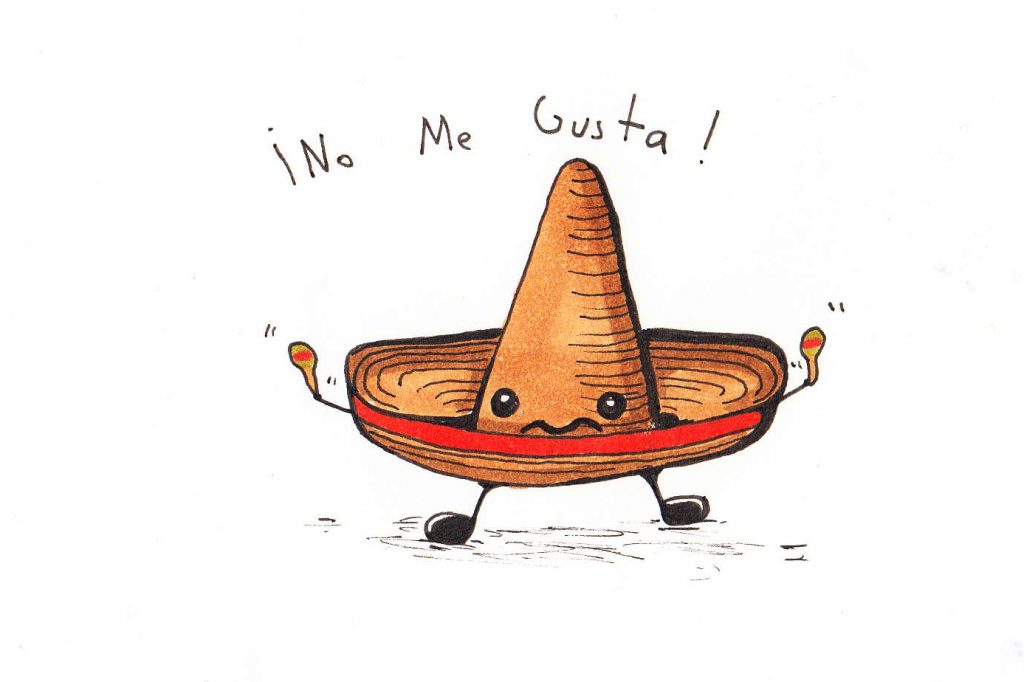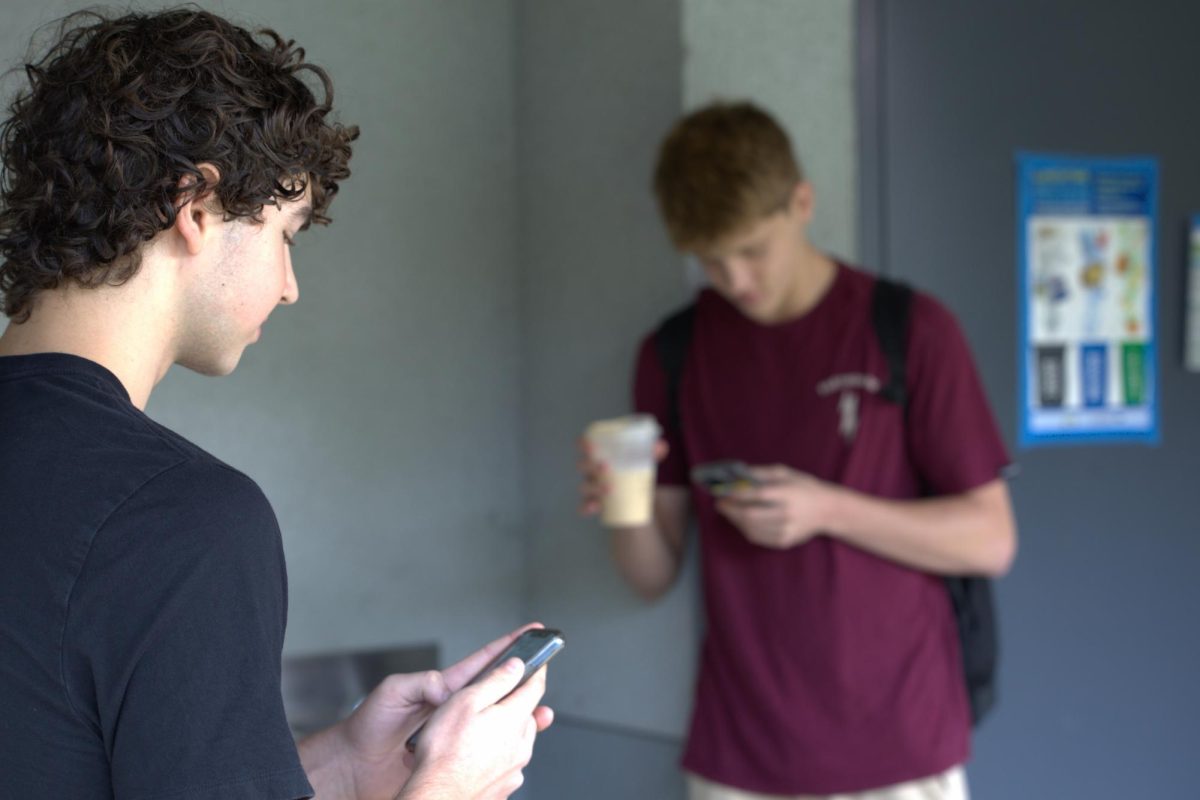
Justin Bieber went to the planet of unicorns. Justin Bieber fue a la planeta de unicornios.
That was one of the first sentences I learned to say in Spanish 1. It may be random, but any student at Foothill knows that it is nowhere out of the ordinary to spend Spanish class making up unconventional tales about anything from magical cacti to one-eyed birds that only eat cheese. Eccentric narratives such as these are the core of Teaching Proficiency Through Reading and Storytelling (TPRS), the teaching method used in Spanish classes here at Foothill.
TPRS is certainly unique and I know that many students enjoy the unorthodox approach to learning a new language. However, I personally believe that, while TPRS is a great program, learning Spanish traditionally is a more effective and efficient way to acquire the language.
Most students at Foothill have only experienced TPRS language learning, but I am a rare exception. I took Spanish I at Foothill my freshman year, but, due to a complication with my sports schedule, ended up taking Spanish One and Spanish Two at Ventura College in 10th grade. Having experienced both teaching methods, I can see why many students learn well in a TPRS class, but I personally believe I learned a lot more in a traditional Spanish class.
In a TPRS class, unusual and intriguing stories keep students involved and interested, while vocabulary is taught through a teaching method called “circling,” where the instructor asks questions about the plot and the kids essentially retell the tale through their answers.
According to Spanish Two teacher Adrian Sanchez, this repetition and reinforcement is what distinguishes TPRS from a traditional Spanish class. He says that TPRS teaches students to gradually acquire a language rather than just memorizing terms. While this is certainly true, it only tells half the story.
It is great that TPRS teaches acquisition and not memorization, but I want to point out that a lot of the vocabulary and sentences I acquired through TPRS were fairly outlandish. Sure, I remember how to say “Justin Bieber went to the planet of unicorns,” but when am I ever going to need to say that?
You could argue that I can use the structure of the sentence to say something more practical such as “I went to the gym,” but that would require outside vocabulary and verb conjugations that I didn’t always know. At times, I felt like I wasn’t learning anything that I could actually use in an everyday conversation, and that discouraged me from continuing with Spanish.
In addition, it may be true that I remember almost everything I learned in TPRS, but I didn’t learn nearly as much as I had hoped to. In Spanish 1 at Foothill, I learned a few structures that I repeated in class for two or three weeks until I knew them by heart. At VC, I learned an equivalent amount of vocabulary every day. Do I remember every word I learned? No, but I still believe I learned more than I did at Foothill because I had the opportunity to learn more vocabulary and, as someone who truly wanted to learn the language, I took steps to actively digest that material outside of the classroom.
Spanish 1 teacher Kathy Leaf told me this year that she realizes some students would successfully learn the extra vocabulary presented in a traditional Spanish class. However, she also says that, having taught Spanish using both methods, she believes the majority of students do not have the extra time.
I will be the first one to admit that it took a lot of dedication to truly learn Spanish in my VC class, and I can see how most students would do their best in a TPRS class where they are coerced into acquiring the language rather than asked to do it on their own. That being said, just because most students do not acquire a language through the traditional teaching method doesn’t mean that other students can’t, and it especially doesn’t mean that they wouldn’t if they were given the opportunity.
I talked to students in every level of Spanish, and, while many people told me they enjoyed TPRS, a fairly large amount of students said they would have appreciated the opportunity to work harder and learn faster in a traditional class.
To me, it seemed similar to the ratio between students in college prep classes and students in AP/Honors classes. This makes sense because, in a way, a traditional Spanish class sounds a bit like an Honors or AP class; there is more outside homework, it moves at a faster pace, and there is more material. In any given subject, the majority of students usually take the college prep course, but that doesn’t mean the number of students taking the Honors class is negligible.
Last year, 108 out of 244 juniors took AP US History. Is that a majority? No, but it is still a fairly large number. If that many students were willing to acquire the massive amounts of information thrown at them by Mr. Geib in order to better understand US history, who’s to say that they wouldn’t want to take a harder course so that they could better learn the Spanish language, and maybe even become bilingual?
Obviously you can become bilingual through TPRS, it happens every year, but many AP Spanish students don’t think TPRS gave them proper training to be fluent by the end of their fourth year. I talked to 15 students in AP Spanish and all of them told me that, while they knew some Spanish, they didn’t learn as much as they’d hoped, and they certainly didn’t consider themselves to be bilingual.
A main issue that several AP students brought up is the fact that they very rarely received specific grammar instruction in TPRS. While it may be true that grammar isn’t on the AP test, that doesn’t mean it shouldn’t be taught. For people who learn mathematically, grammar helps clarify what they are learning and why.
I learn best through patterns and structure, and not learning grammar in Spanish 1 added a level of confusion to the class. It felt like someone was teaching me Algebra by showing me how to solve 6 = 2x – 4 without telling me why I was doing certain operations. All I could do was rewrite the steps to that problem and if someone changed the problem to 6 = ½ x, I was absolutely clueless.
Some might argue that I was learning grammar in TPRS, just not overtly, but the truth is that the lack of explicit instruction made it seem impossible to independently construct sentences. Sure, I learned to recognize basic verb endings, but I lacked the essential understanding of how and when to use them.
Spanish 3 and AP Spanish teacher Steven Perfect said explicit grammar instruction isn’t always necessary. He pointed out that most people learn their first language without ever opening a grammar textbook and that many English speakers don’t know grammar at all. While this is definitely true, most English speakers are also surrounded by nothing but English every day. Naturally, they will be able to just pick up the language, but for students who only listen to four hours of Spanish a week, it isn’t feasible to expect that they could simply understand the grammar without being given any instruction.
Even if I did learn grammar in TPRS, the fact that I didn’t feel like I was learning it discouraged me from continuing with the class. At the end of the day, the goal of any teacher is to inspire their students to continue learning. For students who find TPRS fun, the program encourages them to pursue becoming bilingual, but for the students who would rather be learning mechanics, it does the opposite.
Foothill needs to start thinking about reaching all students, not just the majority. There are AP classes for students who prefer a more rigorous curriculum, so why isn’t there a more in-depth option for students who plan to become bilingual? Leaf says she firmly believes she is reaching more students through TPRS, and I think that Foothill made the right choice in switching to this program, but that doesn’t mean we should forget the minority of students who would better succeed a traditional class.
TPRS is a great program, but it doesn’t work for everyone, so it is time that we pursued an option that doesn’t only please the majority but factors every student and their various learning styles into the equation.















TPRS supporter • Dec 10, 2014 at 7:56 pm
Through all those crazy stories made in Spanish class, using the TPRS method, your brain recognizes the words used and forms neuro pathways through the songs we learn and the high frequency words used when your having a conversation with someone. Although stories about Justin Bieber seem very crazy to people, the person saying it doesn’t realize that your brain makes connections that will last for a very long time and when your actually trying to speak to someone, your brain will automatically know witch words to use in the conversation. So that’s why I support the TPRS system. Because like Claire and Nicole were saying, this actually prepares you better in conversations.
Jill • Jun 11, 2014 at 12:39 pm
As a parent, I have been both intrigued and skeptical of the TPRS method. I learned Spanish the old-fashioned way- conjugating and vocab memorization. My daughter is in Spanish 2 this year and has really enjoyed the class but has felt it has been too easy and is missing out on a crucial component of Spanish by not learning to conjugate and memorize vocab. I’m just curious if anyone knows how many students take the AP Spanish exam and how many pass?
Claire Stockdill • Jun 11, 2014 at 9:35 am
As Nicole stated, the best method by which to learn Spanish, or any language for that matter, boils down to personal preference. I have not experienced traditional language classes in the form Glenda described; however, in my experience with Foothill’s program, TPRS is highly effective and puts a responsibility on the student to make connections from the stories and conversations that take place in class. This, in my opinion, is a more natural and involved way to learn and is more analogous to the way that humans learn language. When you are sitting in a high chair with a bowl of baby food mush on a plastic table in front of you, your parents don’t pull up a conjugation chart on a projector and guide you through lists of printed vocabulary words; rather, parents speak to their young children in short sentence fragments that are often nonsensical and even absurd. Later, the child enters his or her early years of school speaking less-than-perfectly in his or her native language (Iet’s say English for this example), and gradually begins to acquire proper structures, conjugation, spelling, and formal vocabulary. The child does not forget the words that he or she learned sitting in front of the bowl of baby mush; these words are semi-permanently ingrained in the child’s mind, or, as Nicole described, they just “sound right.” The method of learning these words was natural, effortless, and organic, rather than formulaic, formal, and study/memorization oriented. This is how the foundation of language is established.
Spanish One in the TPRS system serves this fundamental purpose. It establishes a foundation, often informal and even nonsensical or absurd. The first year of Spanish, as far as I know, is not designed to cram students minds with vocabulary and conjugation, but rather to establish this organic foundation. Students begin to associate the words they learn with the images that the stories create in their minds, and, even if their usage of vocabulary and structures is not entirely correct, it is a foundation nonetheless. No one expects the aforementioned child’s first sentences in English to have correct word usage and be grammatically sound, and therefore this is not entirely expected of students in their first year of Spanish.
Moving along to Spanish Two, where the concept of “conjugation” of verbs is fully identified, introduced, and implemented. This class begins to apply a structural scaffolding to the nebulous foundation established in Spanish One, and learning becomes less organic and only slightly more formulaic, just as learning evolved with the student’s native language.
It certainly isn’t feasible, with four hours of Spanish a week, that students will fully and naturally understand grammar and conjugation. However, this is where responsibility falls to the student. Because grammar in TPRS classes is not always handed directly to students by the teacher, students are forced into a habit of pattern recognition that soon grows into a natural skill. In traditional classes, these patterns are established artificially and taught more directly, and the student does not have the benefits to memory that come with the personal discovery and recognition of structures and trends in the language. Learning through discovery and experience establishes a more natural foundation rather than a jumble of memorized structures, and it helps to plant the “it just sounds right” idea of language usage.
With its Spanish program, Foothill is not just reaching out to the majority; it is reaching out more than anything to the individual. In my experience with this program, I have found it to be a highly dynamic system in which it is easy to expand one’s knowledge naturally and independently beyond the basic structures taught in class, because the program is not rigidly structured or heavily focused on grammar and conjugation. It establishes an atmosphere that is creative, fun, and experimental in which students can learn as much or as little as they wish to.
Again, the best method for learning a language is mostly governed by personal preference. However, after trying a wide variety of different methods for gaining proficiency in foreign language structures and acquiring vocabulary, I can say that Foothill’s method of teaching is highly effective and allows for a great deal of growth and creativity with Spanish. I am very grateful to be a part of this program and find that the deviation from structured academics has allowed Spanish to become a significant influence in my life.
Nicole Rockholt • Jun 10, 2014 at 8:11 pm
Personally, my mind just became jumbled and my heart sank a little after reading this. While reading this article, it basically stated that the way Foothill teaches Spanish using TPRS does not allow all students to acquire the language and that if you are a math/science person, it may be very difficult for you to learn this way. It also states that there is not really grammar taught when learning through TPRS. Now I want to state my personal opinion.
I started my very first year of Spanish with la Señora Leaf and only came into the class only knowing how to say some basic greetings and “leche”. While reading through this article, what was stated was that “sentences [Glenda] acquired through TPRS were fairly outlandish”. When either la señora Leaf or el señor Sánchez creates a class story, one of the things that they do is ask for class input. That is key because when a student that is learning Spanish gets asked to create a piece of the story it requires them to think about what they want to say and process it in their heads. This involves processing words from English to Spanish and making certain connections between words. Also, when you want to provide input to the story but do not know a certain word, your Spanish teacher will translate it for you, and chances are high that that word will stick with you because you are the one who personally wanted to know it, if that makes any sense. By being able to provide input into the class, it allows for one to stay attentive and be involved with Spanish learning and speaking.
When I ask my native Spanish speaking friend why she uses, por ejemplo, “buen” instead of “bueno” at times, all she can respond with is ” I don’t know, it just sounds right”, and frankly I believe that is how it is supposed to be. By learning through TPRS, there is going to be a repetition of words and phrases used in different context all of the time and eventually, you will be able to put together and speak many sentences without thinking much because they will just “sound right”.
An aspect that is really important that TPRS program covers and traditional Spanish classes do not is actually speaking the language! Yes, you actually have to be able to speak a language it improve in it. Another friend of mind who is taking classes at Ventura College says that they spend most of their time with their noses in notecards and books studying the grammar aspect of Spanish rather than speaking. While this is all fine and dandy for the people who like grammar and dislike conversing, it is not so beneficial to the people who actually need to use Spanish. It is not beneficial when you are placed into a situation where you need to be able to speak Spanish in an emergency. Personally, I am embarrassed when I try to speak Spanish for many reasons and I most definitely prefer reading and writing over speaking, but I know that being able to speak is critical to be able to learn and apply the language to my life. Let’s just say that if you were in Mexico and you saw someone fall of their house and break a leg you would need to act quick. You would not have the time to think “How do I use the indicative mood and present tense to ask this person if they are okay”. You will probably just have to react speaking what you know and what “sounds right” to you. If there are a few grammatical errors, it is not incomprehensible most of the time. The meaning will still get across in the same way that you wanted it to.
Another thing that was mentioned in this article was the idea of repetition and memorization. If you go home and repeat “billetera” and “wallet” over and over again to make a connection between the two words like you would in a traditional Spanish class, how is that any different from eventually learning the word or sentence through the “circling method”? Both of these methods will lead you to the same spot, you will acquire the meaning of that word or sentence.
Do not get me wrong, I am in no way, shape or form saying that taking Spanish at the college is any less better than taking it at Foothill learning through TPRS. I am only saying that I know so many students who do benefit through learning Spanish through TPRS, including myself. Whether you are in a traditional Spanish class or in a class at Foothill, the only way you can truly learn the language is if you are willing. In both of the classes mentioned, there are always going to be some students who are not willing to put in any effort, but that is the only way you can learn. If you go into a class saying that it is going to suck, chances are it will because you are making yourself think that way and not changing your paradigm to see the non-sucky parts of that class. Like mentioned by Glenda, she prefers learning trough the traditional method even though it is “more work”, but that is not necessarily true. To be able to learn through the TPRS program, you have to be willing to provide input, be alert and be willing to learn. If personally you do not like a story where “Justin Bieber fue a la planeta de unicornios”, then that is where you have to step up and create a story that you will actually be able to learn from. I am in all honors classes and I do not believe that traditional Spanish classes would be considered AP classes compared to classes that involve the TPRS program. Learning through a class at Foothill may be just as challenging as a traditional course because it is structured on story making and story telling as well as sentence building and verbally speaking the language. Learning the TPRS way in my opinion requires a more “on the spot” thought process. Yes, a student that is taking a traditional Spanish class will probably know more extended Spanish vocabulary but that does not mean it is the end of the world for a TPRS learner. If someone truly was learning Spanish, they would be able to acquire vocabulary by hearing it used in stories and in conversations that happen in Foothill classrooms. An easy way that Foothill teachers offer to be able get extended vocabulary and be able to hear and see words used in context is by listening to Spanish songs. These songs allow for students to hear new words and also be introduced to the grammatical structure of sentences. I know that I have picked up many words from listening to Spanish songs and I have used them in my finals and in conversations with my friends outside of class.
Anyways, the TPRS program is a program that is constantly evolving and being revised to fit the needs of all of the students that are willing to learn. I know that the Spanish teachers at Foothill are constantly trying to figure out new ways in which would be the best to teach their students and have them truly obtain the Spanish language. Kudos to these teachers because it can be very difficult trying to explain the Spanish language and the many ways it works to a student who has a million and one questions for them. You should try explaining to a student that is trying to learn English why the plural of box is boxes but the plural of ox is oxen. Or how read can be pronounced read or read and how lead can be pronounced lead or lead.(Get it?, I don’t.) My explanation would probably be because it sounds right. Noticing a theme?
In the end, the “better” way to learn Spanish all boils down to your own personal opinion. I just wanted it to be known that I have learned and continue to learn so much. I have benefited a great deal from learning Spanish through the TPRS program and the way the Foothill’s teachers are able to teach it. I would have never guessed that coming into Freshman year I would be able to find a passion that was completely foreign to me, but now I find it taking over my lifestyle and I owe it all to the way that la señora Leaf and el señor Sánchez have taught me Spanish.
Sr. Sánchez • Jun 11, 2014 at 1:54 pm
Este comentario es para las dos, Nicole y Claire. Yo sé que las dos me pueden entender y por eso escribo esto en español. También lo hago para celebrar el hecho de que después solamente dos años en las clases de español pueden entender y producir demasiado lenguaje.
Es increible lo bien que ustedes dos entienden el programa de español y fue un placer poder enseñarles a ambas este año. Es obvio que las dos entendien lo que se toma para poder desarrollar su habilidades en un idioma. Yo pienso que las dos pueden hasta llegar a ser unas excelentes maestras de lenguajes 😉
No saben el gusto, la enorme emoción, que me da al leer este tipo de comentarios. El programa de español siempre está modificando, cambiando e implementando nuevas ideas y estrategias para poder inspirar a estudiantes como ustedes para que continuen con el estudio de idiomas. Ustedes dos son extremadamente especiales porque pueden lograr tanto con el idioma y esa es la razón que ustedes dos pueden saltar el español 3. Sus habilidades son increibles y estoy muy emocionado de poder enseñarles el siguiente año, en español 4AP!!!
Gracias por siempre ser respetuosas y más que nada gracias por ser responsables de su propio aprendizaje… porque el aprendizaje es resposabilidad del maestro, pero también del estudiante.
Hasta pronto chicas.
Nicole Rockholt • Jun 11, 2014 at 10:02 pm
Gracias por decir eso! Pero recuerda, usted ha enseñado bien. Nosotros no podríamos hacerlo sin usted.